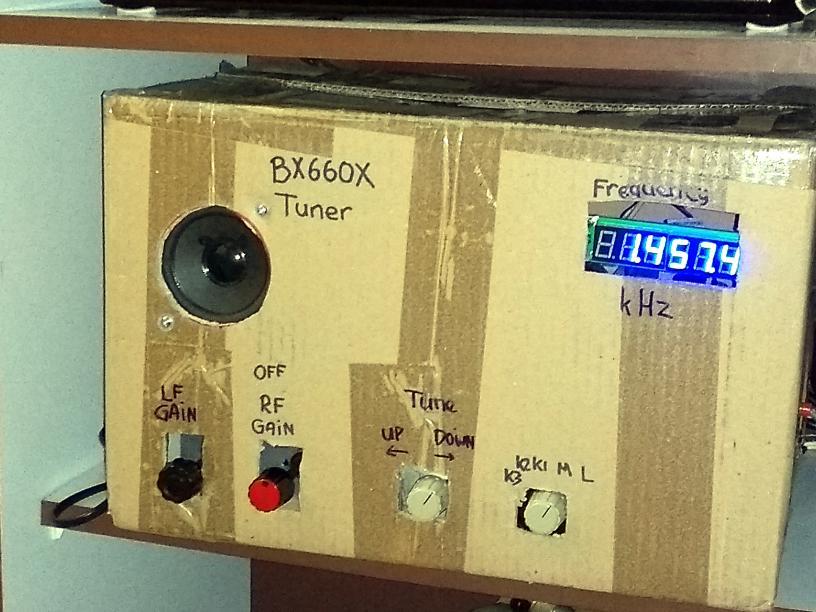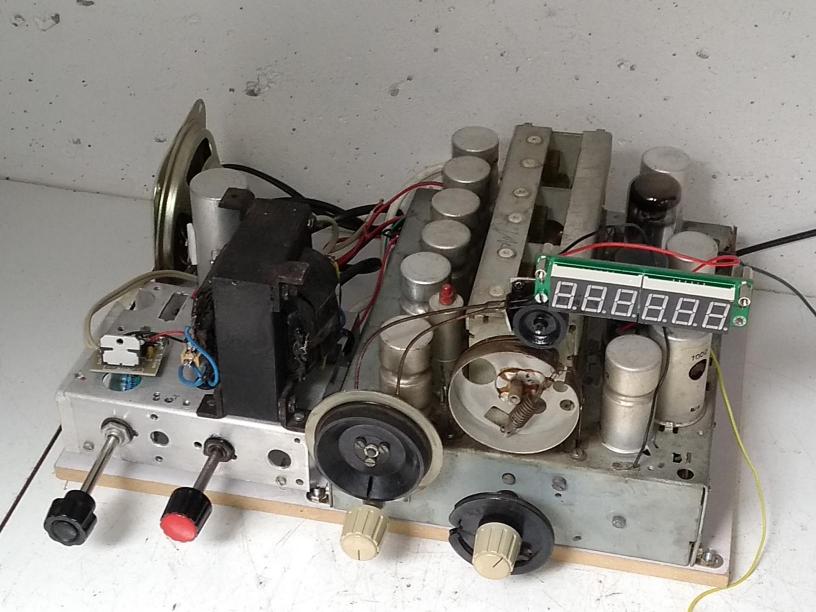
482
Item nr.

Philips BX660X Shortwave receiver
My DIY project: a multiband shortwave receiver.
Data for Philips BX660X
| Production | Netherlands, 1946/2020.
Price was fl 510. |
|---|
| Bands | LW (148-430kHz), MW (530-1705kHz), SW1 (5850-9900kHz), SW2 (9410-15620kHz), SW3 (14890-22030kHz), IF 443kHz (was 452kHz). |
|---|
| Tubes | EF22 (RF amp), ECH21 (converter). |
|---|
Semi-
conductors | TA7642 (tuner IC), LM386 (LF amp), various 1N4007, Cymometer. |
|---|
| Cabinet | Cardboard box.
Size 38x25x30cm.
|
|---|
| Power | 230V (22W). |
|---|
| Documents | Ad for the BX665X. |
|---|
The Design
In its days, around 1946, the Philips BX660X was a marvellous shortwave receiver, featuring HF pre-amplification and an ingeneous bandspread system that was way ahead of its time and never seen again after.  A specially designed shape of the tuning condenser plates caused a strongly bended tuning curve. Six of the eight shortwave broadcast bands were carefully located in the flat parts of the curse. This combines smooth tuning in the broadcast bands with an overall full range coverage of the shortwave spectrum.
A specially designed shape of the tuning condenser plates caused a strongly bended tuning curve. Six of the eight shortwave broadcast bands were carefully located in the flat parts of the curse. This combines smooth tuning in the broadcast bands with an overall full range coverage of the shortwave spectrum. Other brands like Pye, produced radio's with spread coverage of only the broadcast bands, while Eddystone covered the complete specrum but included extreme mechanical reduction in the tuning knob. Despite its ingenuity, the system disappeared as quickly as it had come (it was only used in the BX660X, BX665X, and BX760X). Optimizing plate shapes for shortwave is only possible if the tuner has separate condenser sections for shortwave, so a special six-deck tuning cap is needed to fully apply it.
Don't mistake the BX660X for a Tropicalized set. Tropics sets usually had a 5 as the third digit in the type number, and, indeed, there is a different model BX665X for use in the tropics. It has a Tropical band instead of the Long Wave. The final X in the type number means that the radio is prepared for use from a DC mains, in combination with a high-voltage vibrator unit.
| Obtained | 6/2018
from NVHR Swap Meet; sn=E4306. |
|---|
| Condition | 7; nicely reanimated 70 year old tuner. |
|---|
| FOR SALE | Price is 22 Euros. |
|---|
| Sound sample | PLAY SOUND I receive Radio Rumania quite understandable (for those who understand Rumanian). Unfortunately, a rattling noise is heard over large parts of the shortwave spectrum here. |
|---|
This Object
 When I bought it, it was not a complete radio, just one module of it.
When I bought it, it was not a complete radio, just one module of it.
 My dreamed receiver project was to include it in a radio, together with MF and LF and PS and speaker and cabinet added by me.
My dreamed receiver project was to include it in a radio, together with MF and LF and PS and speaker and cabinet added by me. For the MFpart I chose a simple TA7642-based design and for the LF amplifier an TDA7297 IC. Because the output level of the TA7642 is very low, this TDA7297 didn't give enough gain, and I replaced it by an LM386 amp. Tuning frequency should be indicated by a Cymometer. At first I thought that gain control would not be necessary, so my Power Supply should give 6.3VAC, 200 to 250VDC, and 6 to 8 VDC.

 On the left you see the box with the tuner and some additional parts. In June 2020, I spent a lot of time at home and constructed a small chassis with power transformer, speaker, and LF amp (right). First tests brought to daylight that the tuner IC strongly overloaded, so I added a negative supply to feed the AVC of the tuner as HF gain control.
On the left you see the box with the tuner and some additional parts. In June 2020, I spent a lot of time at home and constructed a small chassis with power transformer, speaker, and LF amp (right). First tests brought to daylight that the tuner IC strongly overloaded, so I added a negative supply to feed the AVC of the tuner as HF gain control.

 Late June I connected all the stuff and got myself a working receiver, with which I did the measurements for the graphs above. The machine actually receives shortwave communications, but it isn't really a very good radio. It performs best with a short antenna, because the TA7642 IC gets overloaded pretty quickly. There is always some noise, the sound is quite sharp, and the frequency counter caused some hum in the speaker. I got rid of this hum by giving the counter its own power supply, taken from the filament supply on the tuner chassis. This also solved a nasty hum problem (probably caused by a ground loop when the counter was fed from the supply in the LF chassis).
Late June I connected all the stuff and got myself a working receiver, with which I did the measurements for the graphs above. The machine actually receives shortwave communications, but it isn't really a very good radio. It performs best with a short antenna, because the TA7642 IC gets overloaded pretty quickly. There is always some noise, the sound is quite sharp, and the frequency counter caused some hum in the speaker. I got rid of this hum by giving the counter its own power supply, taken from the filament supply on the tuner chassis. This also solved a nasty hum problem (probably caused by a ground loop when the counter was fed from the supply in the LF chassis).
Part of Gerard's Radio Corner.
Generated by SiteBuilder on
4/3/2024
by Gerard
(g.tel@uu.nl)

 On the left you see the box with the tuner and some additional parts. In June 2020, I spent a lot of time at home and constructed a small chassis with power transformer, speaker, and LF amp (right). First tests brought to daylight that the tuner IC strongly overloaded, so I added a negative supply to feed the AVC of the tuner as HF gain control.
On the left you see the box with the tuner and some additional parts. In June 2020, I spent a lot of time at home and constructed a small chassis with power transformer, speaker, and LF amp (right). First tests brought to daylight that the tuner IC strongly overloaded, so I added a negative supply to feed the AVC of the tuner as HF gain control. 

 A specially designed shape of the tuning condenser plates caused a strongly bended tuning curve. Six of the eight shortwave broadcast bands were carefully located in the flat parts of the curse. This combines smooth tuning in the broadcast bands with an overall full range coverage of the shortwave spectrum.
A specially designed shape of the tuning condenser plates caused a strongly bended tuning curve. Six of the eight shortwave broadcast bands were carefully located in the flat parts of the curse. This combines smooth tuning in the broadcast bands with an overall full range coverage of the shortwave spectrum.  When I bought it, it was not a complete radio, just one module of it.
When I bought it, it was not a complete radio, just one module of it.  My dreamed receiver project was to include it in a radio, together with MF and LF and PS and speaker and cabinet added by me.
My dreamed receiver project was to include it in a radio, together with MF and LF and PS and speaker and cabinet added by me. 
 Late June I connected all the stuff and got myself a working receiver, with which I did the measurements for the graphs above. The machine actually receives shortwave communications, but it isn't really a very good radio. It performs best with a short antenna, because the TA7642 IC gets overloaded pretty quickly. There is always some noise, the sound is quite sharp, and the frequency counter caused some hum in the speaker. I got rid of this hum by giving the counter its own power supply, taken from the filament supply on the tuner chassis. This also solved a nasty hum problem (probably caused by a ground loop when the counter was fed from the supply in the LF chassis).
Late June I connected all the stuff and got myself a working receiver, with which I did the measurements for the graphs above. The machine actually receives shortwave communications, but it isn't really a very good radio. It performs best with a short antenna, because the TA7642 IC gets overloaded pretty quickly. There is always some noise, the sound is quite sharp, and the frequency counter caused some hum in the speaker. I got rid of this hum by giving the counter its own power supply, taken from the filament supply on the tuner chassis. This also solved a nasty hum problem (probably caused by a ground loop when the counter was fed from the supply in the LF chassis).